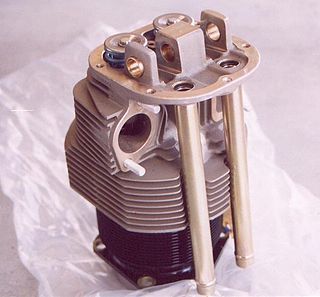Related Research Articles

An aircraft engine, often referred to as an aero engine, is the power component of an aircraft propulsion system. Aircraft using power components are referred to as powered flight. Most aircraft engines are either piston engines or gas turbines, although a few have been rocket powered and in recent years many small UAVs have used electric motors.

The Curtiss OX-5 was an early V-8 American liquid-cooled aircraft engine built by Curtiss. It was the first American-designed aircraft engine to enter mass production, although it was considered obsolete when it did so in 1917. It nevertheless found widespread use on a number of aircraft, perhaps the most famous being the JN-4 "Jenny". Some 12,600 units were built through early 1919. The wide availability of the engine in the surplus market made it common until the 1930s, although it was considered unreliable for most of its service life.

The Pratt & Whitney R-4360 Wasp Major is an American 28-cylinder four-row radial piston aircraft engine designed and built during World War II. At 4,362.5 cu in (71.5 L), it is the largest-displacement aviation piston engine to be mass-produced in the United States, and at 4,300 hp (3,200 kW) the most powerful. First run in 1944, it was the last of the Pratt & Whitney Wasp family, and the culmination of its maker's piston engine technology.

The de Havilland Gipsy Major or Gipsy IIIA is a four-cylinder, air-cooled, inverted inline engine used in a variety of light aircraft produced in the 1930s, including the famous Tiger Moth biplane. Many Gipsy Major engines still power vintage aircraft types.

The Curtiss Robin, introduced in 1928, was an American high-wing monoplane built by the Curtiss-Robertson Airplane Manufacturing Company. The J-1 version was flown by Wrongway Corrigan who crossed the Atlantic after being refused permission to do so.

The Pietenpol Air Camper is a simple parasol wing homebuilt aircraft designed by Bernard H. Pietenpol. The first prototype that became the Air Camper was built and flown by Pietenpol in 1928.

The Siddeley Puma is a British aero engine developed towards the end of World War I and produced by Siddeley-Deasy. The first Puma engines left the production lines of Siddeley-Deasy in Coventry in August 1917, production continued until December 1918. In operational service, the engine was unreliable and failed to deliver its rated power. At least 4,288 of the 11,500 ordered engines were delivered, orders were cancelled following the Armistice. Production was continued under the name Armstrong Siddeley Puma when the manufacturer was bought by Armstrong Whitworth and became Armstrong Siddeley.

Air-cooled engines rely on the circulation of air directly over heat dissipation fins or hot areas of the engine to cool them in order to keep the engine within operating temperatures. Air-cooled designs are far simpler than their liquid-cooled counterparts, which require a separate radiator, coolant reservoir, piping and pumps.

The Rolls-Royce Eagle was the first aircraft engine to be developed by Rolls-Royce Limited. Introduced in 1915 to meet British military requirements during World War I, it was used to power the Handley Page Type O bombers and a number of other military aircraft.

The Armstrong Siddeley Cheetah is a seven-cylinder British air-cooled aircraft radial engine of 834 cu in capacity introduced in 1935 and produced until 1948. Early variants of the Cheetah were initially known as the Lynx Major.

The Curtiss Fledgling, known internally to Curtiss as the Model 48 and Model 51 was a trainer aircraft developed for the United States Navy in the late 1920s and known in that service as the N2C.

The Heath Parasol is an American single or two seat, open-cockpit, parasol winged, homebuilt monoplane.

The Wright R-790 Whirlwind was a series of nine-cylinder air-cooled radial aircraft engines built by Wright Aeronautical Corporation, with a total displacement of about 790 cubic inches (12.9 L) and around 200 horsepower (150 kW). These engines were the earliest members of the Wright Whirlwind engine family.

The Waco 10/GXE/Waco O series was a range of three-seat open-cockpit biplanes built by the Advance Aircraft Company, later the Waco Aircraft Company.

Oakland Aviation Museum, formerly called Western Aerospace Museum, was founded in 1981 as a non-profit organization operating an aviation museum located at North Field of Oakland International Airport in Oakland, California. It has over 30 vintage and modern airplanes, both civilian and military, and other displays that highlight noted aviators and innovators.
The Zanzottera MZ 201 and MZ 202 are a family of twin-cylinder, in-line two-stroke, dual ignition aircraft engines designed for ultralight aircraft and motor gliders.

The Heath-Henderson B-4 engine was a motorcycle piston engine modified for use in aircraft.
The Pietenpol Sky Scout is a parasol wing homebuilt aircraft designed by Bernard Pietenpol.
The Long Anzani Longster AL-1 is an early homebuilt aircraft.
The Long Henderson Longster HL-1 is an American aircraft that was designed by Leslie Long and Ivan Diggs for homebuilt construction.
References
- ↑ "The Plane That Helped Save Homebuilding". Air Progress. Winter 1969.
- ↑ "Some remarkable experiments in lightplane performance". Popular Aviation. November 1935.
- ↑ 1933 Flying Manual (Mechanix Illustrated).
{{cite journal}}: Missing or empty|title=(help) - ↑ "Eagles Mere aircraft museum" . Retrieved 7 October 2013.